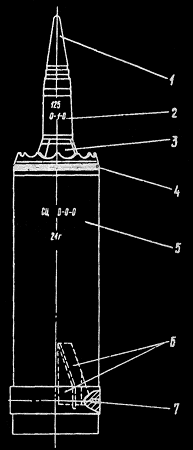125MM APFSDS AMMUNITION
Historical note
USSR has pioneered the use of APFSDS ammunition in tanks loadout with the introduction of
T-62 medium tank. With their extremely high speed and long direct-fire range these rounds could be effectively used at substantial range in spite of the antiquated fire control of T-62. Opposite to the popular belief, it was not however a prefered anti-tank round until the end of seventies, with HEAT being considered more versatile, accurate, and powerful. This, as well as very modest advances in NATO armor protection during this period, resulted in the Soviet APFSDS rounds not changing much in appearance until the 80s, with only evolutionary changes in internal composition; they were nevertheless sufficient for dealing with contemporary NATO armor thanks to significant potential offered by 125mm gun.
The situation changed with the appearance of a new generation of NATO MBTs that featured composite armor with drastically increased protection, especially against HEAT rounds. To deal with new threats required radical departures from earlier Soviet APFSDS designs. The advances included the use of new penetrator materials, in particular high-strength tungsten alloys and uranium, increased round elongation, and new sabot designs with new separation principle, that provided increased interface area with the thinner more fragile rounds and eventually also two areas of contact rather than just one of older sabot designs.
The principal difference of most Soviet APFSDS rounds from the Western ones was that the former used bore-riding fins and the sabot had only one area of contact with the barrel, while the latter overwhelmingly use spool shaped sabots that touch the barrel in two areas and therefore can afford to have subcaliber fins. At first glance there are advantages and disadvantages to both approaches. In Soviet model, the sabot can be made much lighter and therefore the loss of gunpowder energy on acceleration of parasitic mass is smaller. On the other hand, large bore-riding fins produce a high ballistic drag causing severe decceleration of the projectile in flight and affecting stability. The developments of the last decades have shown that the Western approach seems to be more sound. Newest 125mm rounds have moved away from bore-riding fins, and there are many foreign variants of 125mm APFSDS rounds utilizing spool-shaped sabots.
Layout overview
 Most Soviet 125mm APFSDS rounds have the following layout (the round
assembly depicted is 3BM-16/3BM-18): in the front of the projectile is a
ballistic cap (1) which covers the nose of a penetrator body (2); there
is a ring-shaped three-part discarding sabot (3) with a driving band (4);
stability in flight is provided by means of 5 bore-riding fins (6), that are
equipped with ballbearings (7) for centering in the barrel. The round is
assembled with the incremental charge (5).
Most Soviet 125mm APFSDS rounds have the following layout (the round
assembly depicted is 3BM-16/3BM-18): in the front of the projectile is a
ballistic cap (1) which covers the nose of a penetrator body (2); there
is a ring-shaped three-part discarding sabot (3) with a driving band (4);
stability in flight is provided by means of 5 bore-riding fins (6), that are
equipped with ballbearings (7) for centering in the barrel. The round is
assembled with the incremental charge (5).
In addition to the incremental charge integral to the round, the standard propelling charge (4Zh40 or 4Zh52, with newer high-energy rounds - 4Zh63) is used; APFSDS rounds have an initial velocity between 1700 and 1800 m/s, and velocity loss of 60-140 m/s/km depending on the model and current velocity (older models being faster at muzzle, but losing velocity at greater rate).
The separated sabot petals possess significant kinetic energy and are considered a safety hazard out to 1000m and 2° to each side of the gun.

This page is © 2001-2007 Vasiliy Fofanov
 Most Soviet 125mm APFSDS rounds have the following layout (the round
assembly depicted is 3BM-16/3BM-18): in the front of the projectile is a
ballistic cap (1) which covers the nose of a penetrator body (2); there
is a ring-shaped three-part discarding sabot (3) with a driving band (4);
stability in flight is provided by means of 5 bore-riding fins (6), that are
equipped with ballbearings (7) for centering in the barrel. The round is
assembled with the incremental charge (5).
Most Soviet 125mm APFSDS rounds have the following layout (the round
assembly depicted is 3BM-16/3BM-18): in the front of the projectile is a
ballistic cap (1) which covers the nose of a penetrator body (2); there
is a ring-shaped three-part discarding sabot (3) with a driving band (4);
stability in flight is provided by means of 5 bore-riding fins (6), that are
equipped with ballbearings (7) for centering in the barrel. The round is
assembled with the incremental charge (5).
